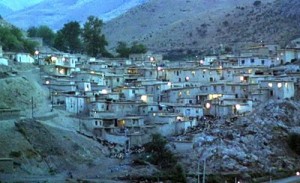THE WIND WILL CARRY US
The following was commissioned by and written for Asia’s 100 Films, a volume edited for the 20th Busan International Film Festival (1-10 October 2015). — J.R.
This ambiguous comic masterpiece of 1999 might be Abbas Kiarostami’s greatest film to date; it’s undoubtedly his richest and most challenging. A media engineer from Tehran (Behzad Dourani) arrives in a remote mountain village in Iranian Kurdistan, where he and his three-person camera crew secretly wait for a century-old woman to die so they can film or tape an exotic mourning ritual at her funeral. To do this he has to miss a family funeral of his own, and every time his mobile phone rings the poor reception forces him to drive to a cemetery atop a mountain, where he sometimes converses with Youssef, a man digging a deep hole for an unspecified telecommunications project. Back in the village the digger’s fiancée milks a cow for the engineer while he flirts with her by quoting an erotic poem by Forough Farrokhzad that gives the movie its title, in a seven-minute sequence that figures as the film’s centerpiece, summarizing all its themes, conflicts, and power relations. (“I’m one of Youssef’s friends — in fact, I’m his boss,” the media engineer remarks smugly at one point.) Read more


